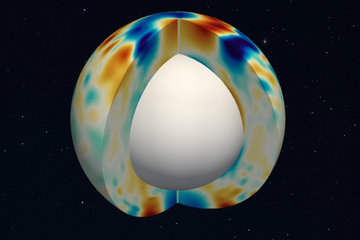All genres
61.
Journal Article
Craters on comets. Planetary and Space Science 107, pp. 53 - 63 (2015)
62.
Journal Article
The rotation state of 67P/Churyumov-Gerasimenko from approach observations with the OSIRIS cameras on Rosetta. Astronomy and Astrophysics 569, L2 (2014)
63.
Journal Article
The contamination of the surface of Vesta by impacts and the delivery of the dark material. Icarus 240, pp. 86 - 102 (2014)
64.
Conference Paper
Spectropolarimetric Investigations of the Deep Photospheric Layers of Solar Magnetic Structures. In: Solar Polarization 5: In Honor of Jan Stenflo, pp. 233 - 236 (Eds. Berdyugina, S. V.; Nagendra, K. N.; Ramelli, R.). (2009)
65.
Talk
Material strength of cliffs and boulders on 67P/Churyumov-Gerasimenko. European Planetary Science Congress, Nantes, France (2015)
66.
Talk
Colors of comet 67P/Churyumov-Gerasimenkos active pits and their surroundings as seen by OSIRIS on board Rosetta. European Geosciences Union General Assembly, Vienna, Austria (2015)
67.
Talk
Colors of active regions on comet 67P. European Planetary Science Congress EPSC , Nantes, France (2015)
68.
Talk
Variegation of active regions on comet 67P/Churyumov-Gerasimenko. Division for Planetary Sciences 48, Washington DC, USA (2015)
69.
Talk
Craters on comets. Asteroids, Comets, Meteors, Helsinki, Finland (2014)
70.
Talk
Jets and sources of activity on 67P observed by OSIRIS. EuroPlanet Science Congress, Cascais, Portugal (2014)
71.
Poster
Comet ISON - From Craddle To Grave, The Approach Phase The Perihelion Passage. Frühjahrstagung der Deutschen Physikalischen Gesellschaft, Arbeitsgemeinschaft Extraterrestrische Forschung e.V., Berlin, Germany (2014)
72.
Poster
Comet ISON from cradle to grave. Asteroids, Comets, Meteors, Helsinki, Finland (2014)
73.
Poster
First time comet observations from National Observatory of Turkey. ACM, Helsinki, Finland (2014)
74.
Poster
First time comet observations from National Observatory of Turkey. EPSC, Lisboa, Portugal (2014)
75.
Thesis - PhD
Spectropolarimetric investigations of the deep photospheric layers of solar magnetic structurex. Dissertation, Georg-August-Universität Göttingen (2011)











